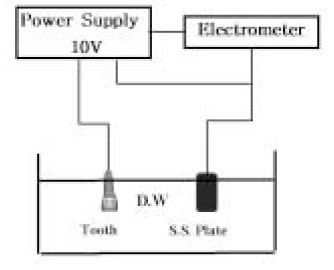J Korean Acad Conserv Dent.
2003 Sep;28(5):363-368. 10.5395/JKACD.2003.28.5.363.
The effect of additional enamel etching on microleakage of the adhesion of self-etching primer system
- Affiliations
-
- 1Department of Conservative Dentistry, College of Dentistry, Dankook University, Korea. endohong@hanmail.net
- KMID: 1987261
- DOI: http://doi.org/10.5395/JKACD.2003.28.5.363
Abstract
- The purpose of this study is to evaluate the effect of additional enamel etching with phosphoric acid on the microleakage of the adhesion of self-etching primer system.
Class V cavity(4 mmx3 mmx1.5 mm) preparations with all margins in enamel were prepared on buccal surface of 42 extracted human upper central incisor teeth. Prepared teeth were randomly divided into 3 groups.
Group 1 : no additional pretreatment with 37% phosphoric acid (NE).
Group 2 : additional pretreatment with 37% phosphoric acid for 10 seconds (E10s).
Group 3 : additional pretreatment with 37% phosphoric acid for 20 seconds (E20s).
The adhesives(Clearfil SE Bond(R), Kuraray, Osaka, Japan) and composite resins(Clearfil AP-X(R), Osaka, Kuraray, Japan) were applied following the manufacturer's instructions. All the specimens were finished with the polishing disc(3M dental product, St Paul, MN, USA), thermocycled for 500 cycles between 5degrees C and 55degrees C and resected apical 3-mm root. 0.028 stainless steel wire was inserted apically into the pulp chamber of each tooth and sealed into position with sticky wax. Surrounding tooth surface was covered with a nail varnish 2 times except areas 1 mm far from all the margins. After drying for one day, soaked the samples in the distilled water. Microleakage was assessed by electrochemical method(System 6514, Electrometer(R), Keithley, USA) in the distilled water.
In this study, the microleakage was the lowest in group 1(NE) and the highest in group 3(E20s)(NE
Keyword
MeSH Terms
Figure
Reference
-
1. Haller B. Recent developments in dentin bonding. Am J Dent. 2000. 13(1):44–50.2. Nakamura K, Arisue K, Kajiwara M, et al. Evaluation of new type of commercially available adhesive systems-effect of total treatment for enamel and dentin. Jpn J Concerv Dent. 1996. 39:304–314.3. Ferrari M, Mannocci F, Vichi A, Davidson CL. Effect of two etching times on the sealing ability of Clearfil Liner Bond 2 in Class V restorations. Am J Dent. 1997. 10(2):66–70.4. Hannig M, Reinhardt KJ, Bott B. Self-etching primer vs phosphoric acid : an alternative concept for composite-to-enamel bonding. Oper Dent. 1999. 24:172–181.5. Fritz UB, Diedrich P, Finger WJ. Self-etching primers-an alternative to the conventional acid etch technique. J Orofac Orthop. 2001. 62(3):238–245.
Article6. Torii Y, Itou K, Hikasa R, et al. Enamel tensile bond strength and morphology of resin enamel interface created by acid etching system with or without moisture and self-etching priming system. J Oral Rehabil. 2002. 29:528–533.
Article7. Kubo S, Yokota H, Sata Y, Hayashi Y. Microleakage of self-etching primers after thermal and flexural loading cycling. Am J Dent. 2001. 14(3):163–169.8. Barkmeier WW, Los SA, Triolo PT Jr. Bond strengths and SEM evaluation of Clearfil Liner Bond 2. Am J Dent. 1995. 8(6):289–293.9. Yoshiyama M, Matsuo T, Ebisu S, Pashley DH. Regional Bond strengths of self-etching/self-priming adhesive systems. J Dent. 1998. 26:609–616.
Article10. Lopes GC, Baratieri LN, de Andrada MA, Vieira LC. Dental Adhesion : Present state of the art and future perspectives. Quintessence Int. 2002. 33(3):213–224.11. Miyazaki M, Sato M, Onose H. Durability of enamel bond strength of simplified bonding systems. Oper Dent. 2000. 25:75–80.
Article12. Sano H, Yoshikawa T, Pereira PN, et al. Long-term durability of dentin bonds made with a self-etching primer, in vivo. J Dent Res. 1999. 78(4):906–911.
Article13. Miyazaki M, Onose H, Moore BK. Effect of operator variability on dentin bond strength of two-step bonding systems. Am J Dent. 2000. 13(2):101–104.14. Ibarra G, Vargas MA, Armstrong SR, Cobbb DS. Microtensile bond strength of self-etching adhesives to ground and unground enamel. J Adhes Dent. 2002. 4(2):115–124.15. Yoshiyama M, Sano H, Ebisu S, et al. Regional strengths of bonding agents to cervical sclerotic root dentin. J Dent Res. 1996. 75(6):1404–1413.
Article16. Gordan VV, Vargas MA, Denthy GE. Interfacial ultrastructure of the resin enamel region of three adhesive systems. Am J Dent. 1998. 11(1):13–16.17. Ogata M, Harada N, Yamaguchi S, et al. Effects of different burs on dentin bond strengths of self-etching primer bonding systems. Oper Dent. 2001. 26:375–382.18. Sano H, Shono T, Takatsu T, Hosoda H. Microporous dentin zone beneath resin impregnated layer. Oper Dent. 1994. 19:59–64.19. Cho YG, Cho KC. Marginal microleakage of self-etching primer adhesives and a self-etching adhesive. J Korean Acad Conserv Dent. 2002. 27(5):493–501.
Article20. Osins BA, Carter JM, Shih-Levine M. Microleakage of four root canal sealer cements as determined by an electrochemical technique. Oral Surg. 1983. 56(1):80–88.
Article21. Jacobsen PH, von Fraunhofer JA. Assessment of microleakage using conductimetric technique. J Dent Res. 1975. 54(1):41–48.
Article22. Jacquot BM, Panighi MM, Steinmetz P, G'sell C. Evaluation of temporary restorations' microleakage by means of electrochemical impedance measurements. J Endod. 1996. 22(11):586–589.
Article
- Full Text Links
- Actions
-
Cited
- CITED
-
- Close
- Share
- Similar articles
-
- Influence of additional etching on shear bond strength of self-etching adhesive system to enamel
- Effect of microleakage of a self-etching primer adhesive according to types of cutting instruments
- Marginal microleakage of self-etching primer adhesives and a self-etching adhesive
- Effect of application methods of a self-etching primer adhesive system on enamel bond strength
- Tooth surface treatment strategies for adhesive cementation


